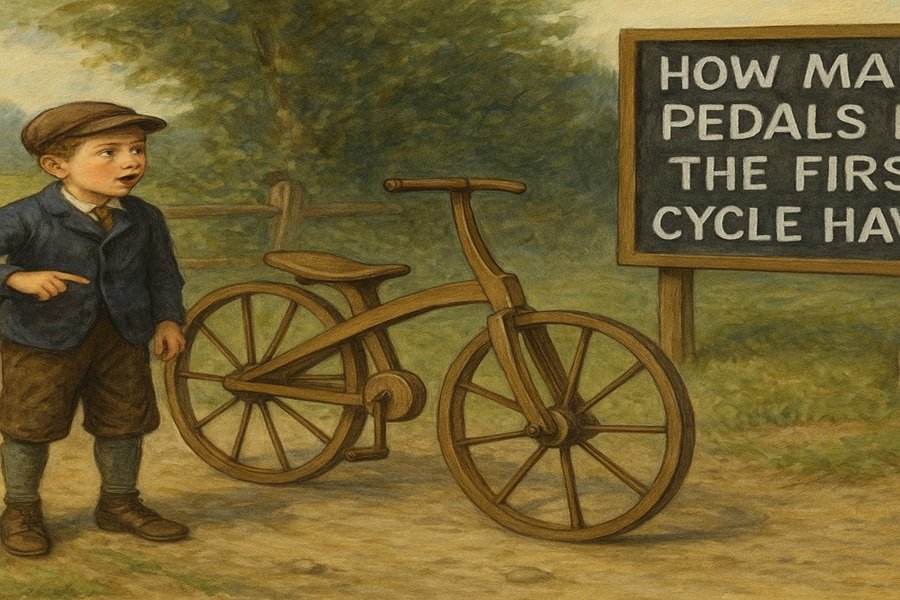
Karl von Drais’s 1817 invention, the first bicycle, didn’t have any pedals (Zero Pedals). Known as a “draisienne” or “velocipede,” it moved forward when the rider pushed off the ground with their feet. This early design also lacked brakes and a proper steering system, which made it hard to control. Now Explore detailed story in this article.
A Historical Deep Dive into the Origins of Pedal-Powered Bicycles
The invention of the bicycle, a machine that has changed the world of transportation, fitness, and recreation, has a fascinating and evolving history. One of the most curious questions that arise when delving into the early designs of the bicycle is: How many pedals did the first cycle have? The short and straightforward answer is two—but the journey to those two pedals is steeped in innovation, trial, error, and mechanical creativity. This article explores the history of early bicycles, the origin of pedals, and the transition from pedal-less designs to modern cycles.
Read This: Which is Colder: Minus 40°C or Minus 40°F?
The Predecessors of the Modern Bicycle: Before Pedals
The Laufmaschine or “Draisine” (1817)
The earliest known form of a bicycle was invented by Karl Drais, a German baron, in 1817. This invention, often called the “Laufmaschine” or “running machine”, is also known as the “Draisine” or “hobby horse” in English.
- Key Features:
- No pedals
- Riders propelled themselves by pushing their feet along the ground
- Wooden frame and wheels
- Steering front wheel via handlebars
So, to answer the question: the earliest cycles had zero pedals. They were essentially balance bikes for adults.
The Birth of Pedals: The Michaux Velocipede (1860s)
The French Breakthrough
The first true pedal-powered cycle emerged in France in the early 1860s, often credited to Pierre Michaux and his son Ernest Michaux, who were blacksmiths and carriage makers.
- They added two pedals directly to the front wheel hub of the velocipede.
- This design was revolutionary at the time and laid the foundation for the modern bicycle.
The Velocipede (“Boneshaker”)
The Michaux pedal-powered cycle became widely known as the “velocipede” or the “boneshaker” due to its rigid iron frame and wooden wheels, which offered little comfort on cobblestone roads.
- Key Features:
- Two pedals attached to the front wheel
- Pedaling turned the wheel directly (no chain mechanism)
- Heavy and uncomfortable, but faster than walking
This was the first cycle with pedals, and it had exactly two pedals, one for each foot—just like modern bicycles.
Why Only Two Pedals?
From a mechanical standpoint, two pedals offer a natural and efficient way to transfer alternating leg power into continuous circular motion, which propels the vehicle forward. More or fewer pedals would have made the system either:
- Inefficient (one pedal would offer no balance),
- Unnecessarily complex (more than two would complicate timing and motion),
- Or mechanically unbalanced.
Thus, two pedals quickly became the standard and still remain so today.
The Evolution of the Pedal Mechanism
The Penny-Farthing (1870s)
In the 1870s, bicycles evolved into the iconic penny-farthing, with a very large front wheel and small rear wheel. The pedals were still attached directly to the front hub.
- Larger front wheel allowed greater speed per pedal stroke
- No chain drive yet
- Difficult and dangerous to mount/dismount
Despite its awkward design, the penny-farthing retained the two-pedal system.
The Safety Bicycle (1880s–1890s)
The next major leap came with the invention of the “safety bicycle”, introduced in the 1880s. This featured:
- Equal-sized wheels
- Chain drive transferring pedal motion to the rear wheel
- Two pedals connected to cranks and a bottom bracket
This design revolutionized cycling. By the 1890s, the safety bicycle with two pedals, a chain drive, and pneumatic tires had become the standard.
Did Any Cycles Have More Than Two Pedals?
While the standard bicycle has always had two pedals, there have been special-purpose or novelty cycles with:
- Four pedals (e.g., tandem bicycles with two riders)
- Hand-and-foot pedal combinations for rehabilitation or fitness machines
- Quadricycles or multi-rider vehicles with separate pedals for each person
However, these are not considered “first bicycles” but rather later innovations or special designs.
Conclusion: Two Pedals Since the Start of Pedal-Powered Cycles
To summarize:
- The earliest cycles had no pedals at all.
- The first pedal-powered cycle, the Michaux velocipede, had two pedals—one for each foot.
- The two-pedal design proved to be mechanically optimal and has remained standard ever since.
- All modern bicycles, regardless of style or complexity, are built around the concept of two alternating pedals for efficient human-powered propulsion.
Thus, the first cycle with pedals had two, and that number has stood the test of time.







